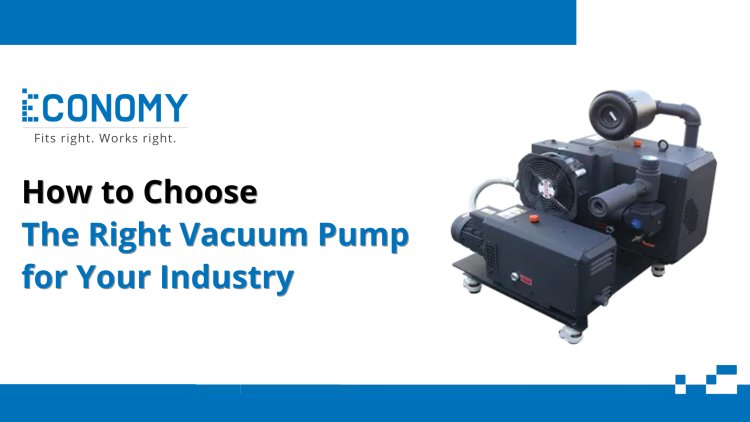How to Choose the Right Vacuum Pump for Your Industry
Selecting the right vacuum pump is crucial for any industrial application, whether in pharmaceuticals, food processing, chemical manufacturing, or electronics.

Selecting the right vacuum pump is crucial for any industrial application, whether in pharmaceuticals, food processing, chemical manufacturing, or electronics. An ill-suited vacuum system can lead to inefficient operations, increased energy costs, frequent breakdowns, and even compromised product quality. Understanding the factors that influence vacuum pump selection is key to optimizing performance, reducing downtime, and ensuring long-term reliability.
Factors Influencing Choice of Vacuum Pump
Every industrial process is unique, and so are its vacuum requirements. How to choose a vacuum pump involves a balance between process needs, system capabilities, and long-term costs. Here are the main factors that influence your selection:
1. Type of Application
The nature of your process—whether it's drying, distillation, degassing, packaging, coating, or filtration—determines the level and type of vacuum required. Some processes need high or ultra-high vacuum, while others work well under low or medium vacuum levels.
2. Vacuum Level and Flow Rate
Vacuum pumps are categorized based on the vacuum range they can achieve (rough, medium, high, or ultra-high) and their pumping speed or flow rate. It's important to match both the required vacuum level and flow rate to avoid over-specifying (which increases cost and energy usage) or under-specifying (which affects efficiency and product quality).
3. Process Gas Composition
What your vacuum pump will be handling—air, moisture, solvents, corrosive gases, particulates—plays a big role in selection. Some pumps are compatible only with clean, dry gases, while others can handle condensables and corrosive vapors.
Major Factors to Consider While Picking a Vacuum System
Once the process specifics are clear, the following parameters will help in narrowing down the best vacuum system:
1. Pumping Technology
Different pumps offer different operating principles—rotary vane, diaphragm, screw, roots blower, diffusion, turbomolecular, etc. For instance, rotary vane pumps are ideal for general-purpose applications, while dry screw pumps are better for chemical processes involving aggressive gases.
2. Oil vs. Dry Operation
Oil-sealed pumps provide effective sealing and are suitable for high vacuum needs but require more maintenance and risk contamination. Dry pumps, on the other hand, are cleaner and better for sensitive environments like semiconductor manufacturing or pharmaceutical clean rooms.
3. Noise and Vibration
Industrial settings might tolerate more noise, but in labs or production lines with strict compliance needs, quieter and vibration-free systems may be preferred.
4. Energy Efficiency
Energy consumption can be a significant operational cost over time. Look for energy-efficient pumps with variable speed drives (VSDs) and smart controls that adjust performance based on demand.
Tips to Align a Vacuum System with the Industry
Each industry has unique operational demands. Aligning your vacuum system accordingly ensures better compatibility and performance.
1. Pharmaceutical Industry
Opt for dry, oil-free vacuum systems to meet contamination-free and GMP-compliant production. Systems with automatic clean-in-place (CIP) features and corrosion-resistant materials are a bonus.
2. Food Packaging and Processing
Choose high-speed, hygienic, and water-tolerant pumps that can handle vapors and meet food-grade standards. Systems must also support continuous operation during peak processing times.
3. Chemical and Petrochemical
Look for explosion-proof, corrosion-resistant pumps that can handle hazardous or reactive gases. Vacuum systems in this industry must comply with strict safety norms like ATEX.
4. Electronics and Semiconductor
Ultra-clean, oil-free high-vacuum systems such as turbomolecular pumps are vital for precision processes. Low vibration and particulate-free operation are crucial.
Common Pitfalls to Avoid
Even when equipped with technical data, it’s easy to overlook some important factors during vacuum system selection. Here are common mistakes to watch out for:
Ignoring Compatibility with Processes
A vacuum pump must match the chemical, thermal, and mechanical demands of your process. Using the wrong material of construction or operating principle may lead to premature failure or hazardous conditions.
Ignoring Maintenance and Durability Features
Low-cost systems may save on initial investment but often come with higher maintenance frequency and downtime. Choose pumps with easy serviceability, long service intervals, and locally available support.
Ignoring Pump Size
Oversizing leads to wasted energy and higher operational costs, while undersizing results in poor vacuum performance. Properly sizing the pump based on real process requirements is crucial. Don’t forget to consider future scalability if your production might grow.
Conclusion
Choosing the right vacuum pump is not just a technical decision—it’s a strategic one that affects productivity, compliance, safety, and total cost of ownership. Start by understanding your process needs, consider technical parameters like vacuum level, flow rate, and gas composition, and always align your choice with your specific industry requirements.
Avoid the common pitfalls of focusing solely on upfront costs or ignoring compatibility. A well-matched vacuum system will reward your operation with long-term reliability, efficiency, and peace of mind.
What's Your Reaction?















.jpg)
.jpg)


